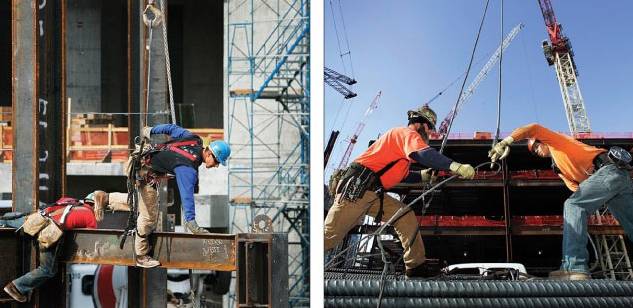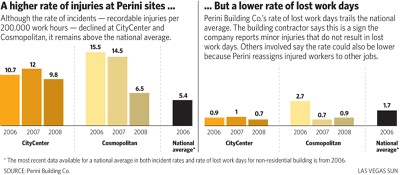
CITYCENTER | NEARLY 1,100 INJURIES : Since 2006, when work on CityCenter began, injuries requiring medical care at the Perini Building Co. site have far outpaced those across the industry. COSMOPOLITAN | ABOUT 240 INJURIES : Perini, also general contractor for the Cosmopolitan, released its injury numbers to the Sun, but said the numbers likely indicate an overly cautious approach.
Wednesday, Oct. 8, 2008 | 2 a.m.
Sun Topics
Beyond the Sun
Workers erecting the CityCenter and Cosmopolitan projects on the Strip are being injured at rates nearly twice the national average for the construction industry, although injuries have fallen sharply in the past year.
The rates were provided to the Las Vegas Sun by Perini Building Co., the general contractor for both projects.
The data show that nearly 1,100 workers have suffered injuries requiring medical care while working at CityCenter, the largest private commercial construction project in the nation.
At the Cosmopolitan, about 240 workers have been injured. Both projects began in 2006.
The national average for nonresidential building projects is 5.4 injuries per 200,000 hours worked. That would translate into 550 injuries at CityCenter and 140 at the Cosmopolitan from inception of the projects through August.
Injuries at the two projects include broken teeth, sprained ankles, dust in the eye, amputated fingers, and scalp and shoulder lacerations. Eight workers have died at the two projects, and four others perished in accidents at other Strip projects, one of which was another Perini site.
The Sun has sought information about accidents on Strip construction sites since late 2007, when the newspaper began looking into construction worker deaths since a $32 billion building boom began two years ago.
General and subcontractors (130 at CityCenter alone) are required to collect injury information for their employees, post it on the site, and provide it to federal and state government agencies when asked. But the information is not available to the public and contractors have not, until now, complied with requests from the Sun for the information.
Perini executives say the injury rates are higher than national averages because the company is more likely than most to send workers with relatively minor injuries for medical care, which results in more reported injuries.
Perini points out that its rate of lost work days ,is lower than national averages.
Others involved in improving safety on the site, however, say that Perini’s lost work-day figures may be lower in part because the company’s projects are so large it can offer more job reassignment — known as “light duty” — for injured workers, which cuts down on days spent without working.
The injuries are occurring on projects in which safety concerns led to a one-day walkout June 3 after a ninth worker died at a Las Vegas Perini project since 2006.
Workers, union leaders and national safety experts have noted that safety problems stem in part from conditions that prevail at many Strip construction projects: crowded sites, heavy reliance on overtime, an influx of out-of-town workers, and tight deadlines.
State investigators called in after fatal accidents found violations by Perini and subcontractors including insufficient training, failure to cover holes in high-rise flooring, and not enforcing fall protection requirements. But the state fines for those violations were relatively small and in some cases were eliminated during informal settlement conferences with Perini and subcontractor executives.
Throughout it all, Perini has insisted it is doing all it can to create safe work sites. In contrast to the assessments by OSHA and national safety experts, Perini insisted the fatal accidents were caused largely by workers who did not take personal responsibility for their safety.
Perini Chairman Craig Shaw, President Mark Caspers and others said in a recent interview with the Sun that safety has not been a problem in Las Vegas.
“At Perini Building Co., we have a process as it relates to safety that we establish on a project,” Caspers said. “This is not unique to CityCenter. This is how we do business.”
The rate of injuries at the Cosmopolitan dropped 52 percent from the beginning of 2007 through August 2008. At CityCenter, injury rates dropped 18 percent over the same period.
Company officials say they have no explanation for the drop.
But others involved in safety efforts at Perini projects praised recent efforts by the company, labor unions and OSHA.
“Absolutely, there’s a change in the culture,” said Greg McClelland, an Ironworkers union representative who has been convening a safety committee since January.
“It is not just a cosmic alignment of the stars that makes the injury rates go down,” McClelland said. “There is a palpable effort by everybody at CityCenter to make things better.”
Since the walkout in June, every worker has been required to undergo 10 hours of OSHA-certified safety training. The training was negotiated as a condition for workers to return to their jobs. But Perini said it had planned to require the training even before the walkout.
Union leaders also point to the increased involvement by Nevada OSHA.
The agency announced after the walkout that it was teaming up with federal OSHA to conduct a comprehensive inspection of every contractor on the CityCenter and Cosmopolitan sites. When inspectors are present, contractors make an especially strong effort to ensure there are no visible safety problems, workers have said.
Union representatives also say Perini has done more to pressure workers to follow safety rules.
“They’ve been getting progressively better as time moves forward,” said Marc Furman, president of the Southwest Regional Council of Carpenters.
Perini executives Caspers and Shaw deny they have made any changes as a result of the recent fatalities, public outcry or an OSHA administrator’s statement in 2007 that the company was putting productivity ahead of safety.
Identifying and discussing safety hazards is the first topic at weekly staff coordination meetings, they said. All accidents are thoroughly investigated. More than 30 Perini and about 50 subcontractor safety professionals wander the site to identify safety hazards and fire workers who repeatedly violate safety laws, the executives said.
On the other hand, pressure to finish the projects on time has not eased.
“The biggest thing for our subcontractors is that even though there’s a lot of construction work in town, it’s a relatively small community and their safety records are considered as we move from one project to the next, as is our ability to be rehired and the ability by the subcontractors to be rehired by us,” Shaw said.
The company has long offered employee rewards for safety, including barbecues and T-shirts. But newer practices have been designed to emphasize — even market — to workers the company’s philosophy that they need to take more responsibility for their own safety.
Last year, Perini began conducting safety events at CityCenter. Every few months, the top executive team calls workers down and asks them to air their safety concerns.
That’s simply part of a natural evolution of safety practices, the company says.
Sun reporter Alex Richards contributed to this story.


Join the Discussion:
Check this out for a full explanation of our conversion to the LiveFyre commenting system and instructions on how to sign up for an account.
Full comments policy